Camino de Santiago - French Way - Stage 2 - Roncevalles to Larrasoaña
Total distance: 27 kilometres
Leaving Roncevalles you will pass the Cruz de los Peregrinos erected in 1880 by Prior Don Francisco Polite. After about 200 metres you will come across a map of the Camino and the beginning of a woodland track which leads you towards Burguete (known as Auritz in the Basque dialect).
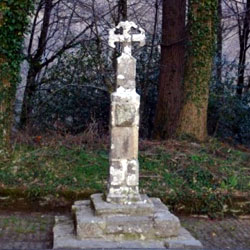
Not to spook anyone who walks through these woods but they do have a couple of legends attached to them. The first is that in the 16th century a coven of witches was believed to be based here. Whether this is true or not it unfortunately led to nine people being burnt at the stake by the Inquisition for practising witchcraft.
Another story pertains to that of the Queen Juana de Labrit who was Enrique IV's (Henry IV) mother who died from poisoning in Paris in June 1572. A rumour circulated at the time was that Catherine de Medici, Henry's future mother-in-law, sent Juana a pair of perfumed gloves that had been poisoned. She did in fact die from natural causes but then that spoils the mythology of it all.
A Catholic who chose to convert to Calvinism upon ascending to the Navarran throne, Juana banished priests and nuns from the region, destroyed catholic churches and prohibited the Catholic ritual. Her body was reputed to have been stolen by Lamias, creatures with serpent's bodies and women's faces, and brought to the forest surrounding Irati. On stormy nights they would come out and destroy churches until the locals found that those that had been built on a Saturday were not touched, therefore the locals would then build their churches this way and therefore liberated themselves from the spirits.
Approximately 3 kilometres out of Roncevalles, Burguete is a beautiful village with most of the whitewashed houses having been built in the 18th century in response to the increase of pilgrims through the region. It is a calm and relaxed village surrounded by woodland filled with oak, hazel, ash and poplar.
Ernest Hemingway, the novelist, is reported to have stayed at the Hostal Burguete on his way to the Fiesta de San Fermin (the running of the bulls) and mentions Burguete in his book "The Sun also Rises". He had stopped to fish for trout in the River Irati and even wrote to his friend and fellow writer F Scott Fitzgerald saying "heaven would be a big bull ring with me holding two barrera seats and a trout stream outside that no one else was allowed to fish in".
For the pilgrim there are a number of cafés, hotels, a bakery, a bank and for those already suffering from blisters, the welcome sight of a pharmacy.
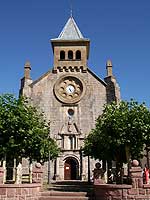
As you continue your Camino you will pass 17th century Iglesia de San Nicolas de Bari, a saint closely linked with the Camino de Santiago and a protector of pilgrims. Using the wooden bridge cross over the Rio Urrobi (more a stream than a river) and after about 200 metres take a left over another bridge onto a minor road. Soon this road becomes a track and will eventually take you through some woods, all the while going uphill. After approximately 4 kilometres you will reach the Iglesia San Bartolomé at the entrance to the village of Espinal (also known as Aurizberri). Founded in 1269 by King Teobaldo II, like its neighbour Burguete it was destroyed by fire by the French in the 17th century.
In the village you will find plenty of places to eat and drink including bars, restaurants and a bakery (panaderia) and small shop. There are also a couple of guest houses (casas rurales) here if you were unable to find somewhere to stay in Roncevalles as well as a private Albergue.
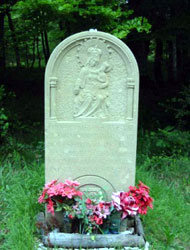
Following the signs out of the village you will come across a quiet road that will lead you to a track and up some steps towards the beech woods and towards the Alto de Mezquiriz 1.5 kilometres from Espinal. Here you will find a plaque written in French, Spanish and Basque to the Virgin and Child, asking the pilgrim to pray for Notre-Dame de Roncevaux (our lady of Roncevalles). From the Alto de Mezquiriz there is a steep downward path which runs parallel with the main road. In recent years this has been resurfaced and can be slippery when wet and can be extremely dangerous when icy.
About 3 kilometres further along the path you will come to the village of Viskarret (Biskarreta in Basque) where you will find a café. You can also get your Credencial stamped at the village church. Upon leaving the village you will come to the River Erro where you can cross the river using the stepping stones then walk past the cemetery. Once past the cemetery take the middle of the three paths then cross the main road and down a track into the small hamlet of Linzoan. Walking under a wooden bridge linking one of the hamlet's stone houses with a high walled garden, this path leads you to a steep uphill dirt track which begins to level out a bit after a couple of kilometres before it begins to descend.
After a further kilometre or two you will reach the mountain pass called Alto de Erro where once there was a refuge for pilgrims called the Venta del Puerto but which now stands in ruins. Thankfully from here on in the path continues to descend towards the town of Zubiri approximately 4 kilometres away.
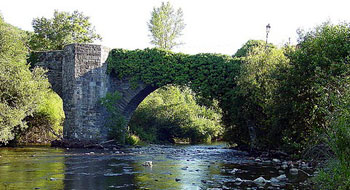
Zubiri is located about mid way between Roncevalles and the city of Pamplona and is considered an essential stop on the Camino Frances. Here you will find the medieval Puente de la Rabia from which the town gets its name (Zubiri means village with the bridge in the Basque language).
Legend has it that this bridge has a supernatural power. It is said that if a rabid animal is led around the central pillar three times it will be cured of the disease. Some say the reason for this is that a local saint named Santa Quiteria is buried beneath the bridge.
In Zubiri you will find a couple of Albergues (one private/one municipal) as well as some hostels and pensiones. Within the town there is also a grocery store, a bakery and a bank.
When you leave Zubiri you will follow a well marked path past an industrial estate called Magnesitas because of its magnesium factory. The path will then lead you through the small villages of Llarratz and Esquirroz following the Arga river valley towards Larrasoaña 5.5 kilometres away.
Soon after leaving the hamlet of Esquirotz you will come to a map of the Camino. At this point you have a choice to make, do you continue on the Camino, or do you take a slight detour into Larrasoaña? Well we will be taking the slight detour.
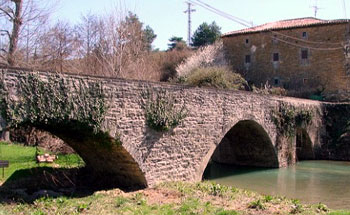
To get to Larrasoaña you need to cross the 14th century gothic bridge Puente Larrasoaña, also known as el Puente de los Bandidos (the bridge of the bandits). The bridge got its name in medieval times due to opportunistic bandits lying in wait to rob the pilgrims coming to the village. Thankfully this doesn't happen anymore.
In Larrasoaña you will find the very popular Albergue Larrasoaña, which is actually run by the village's mayor. There are also 3 pensiones as well as a bar which offers a Pilgrim's menu and a small shop.
Larrasoaña is the first of the villages along the Camino known as a Pueblo Calle were the village is built around the main street rather than around a church or monastery. This was a good design as it focussed the centre of economic activity on the centre of the village.

